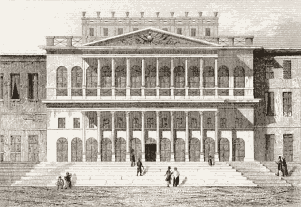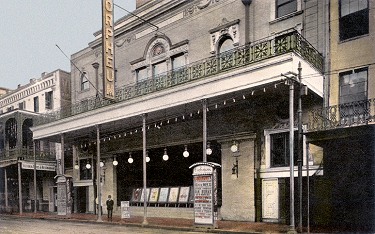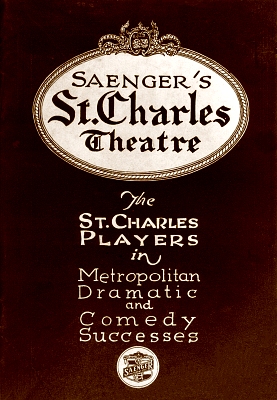| |

What
do you get when a theatre is constructed by a brilliant man driven by
an ambition to control the entire theatrical business in the southeast,
driven also to mount theatrical productions only to his own lofty
standards, & who has money enough from previous theatrical
management & other successful commercial enterprise to do things
the way he wants?
The St. Charles Theatre: the most important
theatre in the southeast, one of the most luxurious theatres in the
world, & the strategic center of one of the most energetic, bitter,
& entertaining struggles for control of power in the theatre
business.
James Caldwell firmly
established theatrical productions in English in New Orleans, was
successful enough to then build the first permanent theatre for English
productions in New Orleans (the American Theatre), established touring
theatrical companies of the highest quality based from his theatre,
& then retired in 1833 from his successful theatrical management
career to concentrate on his civic projects which included establishing
municipal gas works in New Orleans.
On November 30, 1835, he returned to show buisiness in a big way with the opening of his St. Charles Theatre.
Caldwell,
a successful performer as well as manager, went for visual impact with
his productions, & his St. Charles Theatre was to be his biggest
production ever. The theatre was designed by Antonio Mondelli,
Caldwell's scenic artist from the American Theatre.
Composition was not enough; Caldwell wanted scale, too. The $350,000
theatre was enormous & extravagant. Located on St.Charles Street
between Poydras & Gravier, it extended almost to Camp Street. Its
front was 130 feet wide, & the facade included a balustrade
decorated with statues of Apollo & the muses. Inside, the
auditorium featured 4,000 seats, 47 boxes draped in crimson, blue &
yellow silk, and gilded columns flanking what was probably the largest
stage in the country -- ninety by ninety-five feet.
The opening night program included overtures from the 29 piece orchestra, the plays The School for Scandal and The Spoiled Child, and an orchestral interlude of the overture to Der Freischütz.
The
theatre was opened before its interior decoration was completed, &
the local newspaper felt that "The house is at present cold &
cheerless." At the opening of the theatre's second season, both of
those problems were remedied by the installation of the St. Charles
Theatre's most famous feature: an enormous chandelier 12 feet high
& 30 feet in circumference of 23,000 crystal prisms illuminated by
176 gas jets.
Caldwell assembled for the St.
Charles Theatre a stock company of many of the best actors in the
United States & based touring companies derived from this company
to tour theatres all over the southeast. Quite often, his stock actors
played supporting roles, as Caldwell's programming was based on the
"star system": attracting the biggest theatrical stars in the country
with high salaries & wide exposure in shows at the St. Charles
& touring the rest of his circuit for limited runs in each theatre.
The
St. Charles Theatre was referred to as "The Temple of the Drama", and
became a center of amusements for all of New Orleans. Starring actors
were constant; productions were popular and ran from the drama's
classics of tragedy & comedy, to melodrama & farces, to opera,
and to variety acts such as horse shows, acrobats, jugglers, singers
& comics.
On March 13, 1842, a coffin
factory behind the theatre caught fire. The fire spread to the theatre,
and New Orleans' beloved St. Charles Theatre burned to the ground.
We
gazed in mute amazement of the terrific sight until the colossal statue
of Tragedy, which adorned the front of the building caught on fire, and
the mask of her dramatic sister, Comedy, was likewise in flames....From
the extended arms of Tragedy the fire glowed with surprising effect.
When the blaze died away, after having consumed the outer painting, her
hands were a coal of fire, red as Lady Macbeth's after dipping hers in
the blood of Duncan; whilst the face of Comedy was as Lady Teazle when
discovered in the apartments of Joseph Surface. They were the last
mementos of the exquisite and sublime representations we had witnessed
in the Temple, and when they fell from their pedestals, we turned with
a moist eye and heaving bosom; we had witnessed the last scene of the
St. Charles. The curtain had fallen to rise no more, and the glory of
the drama has vanished forever.
-- New Orleans Bee, March 14, 1842, quoted in Nelle Smither's A History of the English Theatre in New Orleans
|
|


